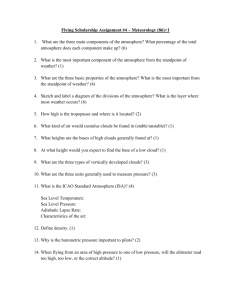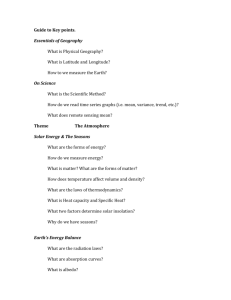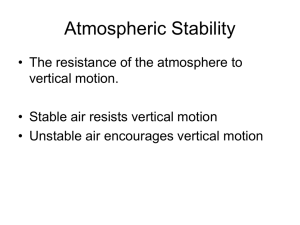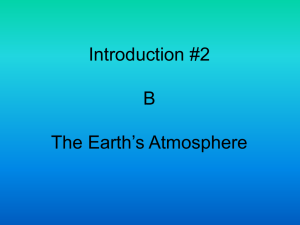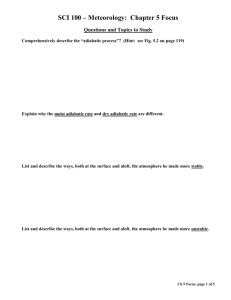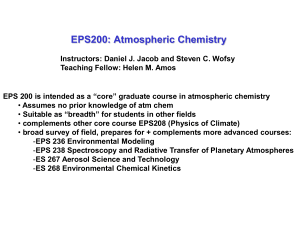COLD HOT THE HADLEY CIRCULATION (1735): global sea breeze
advertisement
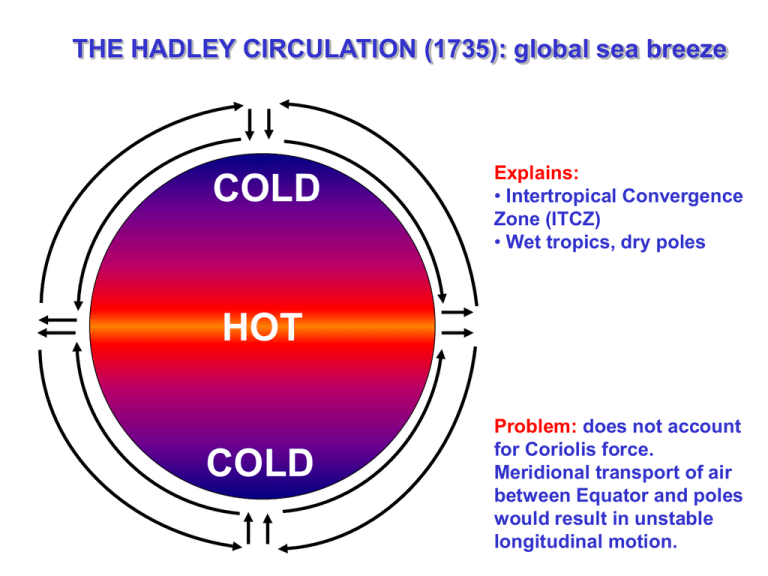
THE HADLEY CIRCULATION (1735): global sea breeze COLD Explains: • Intertropical Convergence Zone (ITCZ) • Wet tropics, dry poles HOT COLD Problem: does not account for Coriolis force. Meridional transport of air between Equator and poles would result in unstable longitudinal motion. GLOBAL CLOUD AND PRECIPITATION MAP 20 Feb 2003 @12Z (intellicast.com) TROPICAL HADLEY CELL • Easterly “trade winds” in the tropics at low altitudes • Subtropical anticyclones at about 30o latitude CLIMATOLOGICAL SURFACE WINDS AND PRESSURES (January) CLIMATOLOGICAL SURFACE WINDS AND PRESSURES (July) TIME SCALES FOR HORIZONTAL TRANSPORT (TROPOSPHERE) 1-2 months 2 weeks 1-2 months 1 year QUESTIONS 1. Is the general atmospheric circulation stronger (i.e., are the winds faster) in the winter or in the summer hemisphere? 2. Is pollution from North America more likely to affect Hawaii in winter or in summer? 3. Concentrations of CO2, krypton-85, and other gases emitted mainly in the northern hemisphere DECREASE with altitude in the northern hemisphere but INCREASE with altitude in the southern hemisphere. Explain. VERTICAL TRANSPORT: BUOYANCY • What is buoyancy? Balance of forces: buoyancy P gradient gravity r r g r z+Dz Fluid (r’) Object (r) z Note: Barometric law assumed a neutrally buoyant atmosphere with T = T’ T P gradient gravity ) T’ would produce bouyant acceleration ATMOSPHERIC LAPSE RATE AND STABILITY “Lapse rate” = -dT/dz Consider an air parcel at z lifted to z+dz and released. It cools upon lifting (expansion). Assuming lifting to be adiabatic, the cooling follows the adiabatic lapse rate G : z stable G = 9.8 K km-1 g G dT / dz 9.8 K km-1 Cp z unstable inversion unstable What happens following release depends on the local lapse rate –dTATM/dz: ATM • -dTATM/dz > G e upward buoyancy amplifies (observed) initial perturbation: atmosphere is unstable • -dTATM/dz = G e zero buoyancy does not alter perturbation: atmosphere is neutral • -dTATM/dz < G e downward buoyancy relaxes T initial perturbation: atmosphere is stable • dTATM/dz > 0 (“inversion”): very stable The stability of the atmosphere against vertical mixing is solely determined by its lapse rate EFFECT OF STABILITY ON VERTICAL STRUCTURE WHAT DETERMINES THE LAPSE RATE OF THE ATMOSPHERE? • • An atmosphere left to evolve adiabatically from an initial state would eventually tend to neutral conditions (-dT/dz = G ) at equilibrium Solar heating of surface disrupts that equilibrium and produces an unstable atmosphere: z z ATM G z final G ATM T Initial equilibrium state: - dT/dz = G G initial T Solar heating of surface: unstable atmosphere T buoyant motions relax unstable atmosphere to –dT/dz = G • Fast vertical mixing in an unstable atmosphere maintains the lapse rate to G. Observation of -dT/dz = G is sure indicator of an unstable atmosphere. IN CLOUDY AIR PARCEL, HEAT RELEASE FROM H2O CONDENSATION MODIFIES G Wet adiabatic lapse rate GW = 2-7 K km-1 z T RH “Latent” heat release as H2O condenses RH > 100%: Cloud forms GW 2-7 K km-1 G 9.8 K km-1 100% GW G VERTICAL PROFILE OF TEMPERATURE Mean values for 30oN, March Altitude, km Radiative cooling (ch.7) - 3 K km-1 2 K km-1 Radiative heating: O3 + hn e O2 + O O + O2 + M e O3+M heat Radiative cooling (ch.7) - 6.5 K km-1 Latent heat release Surface heating SUBSIDENCE INVERSION typically 2 km altitude QUESTIONS 1. An atmosphere with GW < -dT/dz < - G is called "conditionally unstable" (GW is the wet adiabatic lapse rate). Why? 2. Kuwaiti oil fires during the Persian Gulf war produced large clouds of soot a few km above the Earth's surface. Soot absorbs solar radiation. How would you effect such clouds to affect atmospheric stability? 3. Vertical profiles of concentrations of species emitted at the surface often show a "C-shape", particularly in the tropics, with high concentrations in the lower and upper troposphere and low concentrations in the middle troposphere. How would you explain such a profile? DIURNAL CYCLE OF SURFACE HEATING/COOLING: z Subsidence inversion MIDDAY 1 km Mixing depth NIGHT 0 MORNING T NIGHT MORNING AFTERNOON FRONTS WARM FRONT: WIND WARM AIR Front boundary; inversion COLD AIR COLD FRONT: WIND WARM AIR COLD AIR inversion TYPICAL TIME SCALES FOR VERTICAL MIXING • Estimate time Dt to travel Dz by turbulent diffusion: Dz ) Dt 2 2K z with K z 5 10 cm s tropopause (10 km) 10 years 5 km “planetary 2 km boundary layer” 0 km 1 month 1 week 1 day 2 -1
